Product Description
Flexible flex Fluid Chain Jaw flange Gear Rigid Spacer PIN HRC MH NM universal Fenaflex Oldham spline clamp tyre grid hydraulic servo motor shaft Coupling
Product Description
The function of Shaft coupling:
1. Shafts for connecting separately manufactured units such as motors and generators.
2. If any axis is misaligned.
3. Provides mechanical flexibility.
4. Absorb the transmission of impact load.
5. Prevent overload
We can provide the following couplings.
| Rigid coupling | Flange coupling | Oldham coupling |
| Sleeve or muff coupling | Gear coupling | Bellow coupling |
| Split muff coupling | Flexible coupling | Fluid coupling |
| Clamp or split-muff or compression coupling | Universal coupling | Variable speed coupling |
| Bushed pin-type coupling | Diaphragm coupling | Constant speed coupling |
Company Profile
We are an industrial company specializing in the production of couplings. It has 3 branches: steel casting, forging, and heat treatment. Main products: cross shaft universal coupling, drum gear coupling, non-metallic elastic element coupling, rigid coupling, etc.
The company mainly produces the industry standard JB3241-91 swap JB5513-91 swc. JB3242-93 swz series universal coupling with spider type. It can also design and produce various non-standard universal couplings, other couplings, and mechanical products for users according to special requirements. Currently, the products are mainly sold to major steel companies at home and abroad, the metallurgical steel rolling industry, and leading engine manufacturers, with an annual production capacity of more than 7000 sets.
The company’s quality policy is “quality for survival, variety for development.” In August 2000, the national quality system certification authority audited that its quality assurance system met the requirements of GB/T19002-1994 IDT ISO9002:1994 and obtained the quality system certification certificate with the registration number 0900B5711. It is the first enterprise in the coupling production industry in HangZhou City that passed the ISO9002 quality and constitution certification.
The company pursues the business purpose of “reliable quality, the supremacy of reputation, commitment to business and customer satisfaction” and welcomes customers at home and abroad to choose our products.
At the same time, the company has established long-term cooperative relations with many enterprises and warmly welcomes friends from all walks of life to visit, investigate and negotiate business!
How to use the coupling safely
The coupling is an intermediate connecting part of each motion mechanism, which directly impacts the regular operation of each motion mechanism. Therefore, attention must be paid to:
1. The coupling is not allowed to have more than the specified axis deflection and radial displacement so as not to affect its transmission performance.
2. The bolts of the LINS coupling shall not be loose or damaged.
3. Gear coupling and cross slide coupling shall be lubricated regularly, and lubricating grease shall be added every 2-3 months to avoid severe wear of gear teeth and serious consequences.
4. The tooth width contact length of gear coupling shall not be less than 70%; Its axial displacement shall not be more significant than 5mm
5. The coupling is not allowed to have cracks. If there are cracks, it needs to be replaced (they can be knocked with a small hammer and judged according to the sound).
6. The keys of LINS coupling shall be closely matched and shall not be loosened.
7. The tooth thickness of the gear coupling is worn. When the lifting mechanism exceeds 15% of the original tooth thickness, the operating mechanism exceeds 25%, and the broken tooth is also scrapped.
8. If the elastic ring of the pin coupling and the sealing ring of the gear coupling is damaged or aged, they should be replaced in time.
Certifications
Packaging & Shipping
/* January 22, 2571 19:08:37 */!function(){function s(e,r){var a,o={};try{e&&e.split(“,”).forEach(function(e,t){e&&(a=e.match(/(.*?):(.*)$/))&&1

Are there specialized hydraulic couplings for high-pressure or high-flow applications?
Yes, there are specialized hydraulic couplings designed to meet the demands of high-pressure and high-flow applications. These specialized couplings are engineered to handle the increased loads, pressures, and flow rates typically encountered in industrial settings where heavy-duty equipment and machinery are used. Here are some types of hydraulic couplings commonly used in such applications:
- High-Pressure Hydraulic Couplings: High-pressure hydraulic couplings are constructed with robust materials and advanced sealing technologies to withstand extreme pressure levels. They are commonly used in hydraulic systems that operate at pressures exceeding standard hydraulic system limits. These couplings ensure reliable power transmission and prevent leakage or failure under high-pressure conditions.
- Quick-Disconnect Couplings: Quick-disconnect couplings, also known as quick-release or quick-connect couplings, are designed for rapid and efficient connection and disconnection of hydraulic lines. They are prevalent in high-flow applications where frequent connections and disconnections are necessary, such as in construction equipment, agricultural machinery, and manufacturing processes.
- Multi-Couplings: Multi-couplings allow the simultaneous connection of multiple hydraulic lines with a single motion. These couplings are suitable for applications with complex hydraulic circuits, such as material handling systems and mobile hydraulics. They simplify the connection process and minimize downtime during equipment setup or maintenance.
- High-Flow Hydraulic Couplings: High-flow hydraulic couplings are designed to accommodate large volumetric flow rates in hydraulic systems. They feature larger passageways and flow channels to reduce pressure drop and ensure efficient fluid transfer in applications like heavy machinery, material handling, and large-scale industrial processes.
- Flush Face Couplings: Flush face couplings provide a leak-free connection when connected or disconnected. They are suitable for high-pressure applications where minimizing fluid loss during connection and disconnection is critical for safety and environmental reasons.
- Flat Face Couplings: Flat face couplings are ideal for high-pressure applications where cleanliness and contamination control are essential. Their flat mating surfaces prevent trapping debris during connection, making them suitable for construction equipment, mining machinery, and other rugged applications.
- High-Temperature Hydraulic Couplings: High-temperature hydraulic couplings are designed to operate in extreme temperature environments, such as those encountered in hot industrial processes or near machinery generating significant heat. They use specialized seals and materials that can withstand elevated temperatures without compromising performance.
Specialized hydraulic couplings are engineered to handle the unique challenges posed by high-pressure or high-flow applications, ensuring safe, efficient, and reliable operation in demanding industrial environments. When selecting a hydraulic coupling for such applications, it’s crucial to consider factors like the specific pressure and flow requirements, environmental conditions, compatibility with the hydraulic fluid, and the overall system design to achieve optimal performance and safety.

How do hydraulic couplings ensure efficient torque transmission and prevent fluid leaks?
Hydraulic couplings are designed with specific features to ensure efficient torque transmission and prevent fluid leaks, making them vital components in hydraulic systems. These features contribute to the overall performance and reliability of the hydraulic system. Here’s how hydraulic couplings achieve these goals:
- High-Quality Materials: Hydraulic couplings are manufactured using high-quality materials, such as steel, stainless steel, brass, or other durable alloys. These materials offer excellent strength and wear resistance, allowing the couplings to withstand high torque and pressure loads without deforming or leaking.
- Precision Machining: Hydraulic couplings undergo precise machining processes to achieve tight tolerances and smooth surfaces. This ensures proper alignment and mating of coupling components, minimizing energy losses and enhancing torque transmission efficiency.
- Sealing Mechanisms: Hydraulic couplings incorporate various sealing mechanisms to prevent fluid leaks. O-rings, seals, or face seals are common sealing methods used in hydraulic couplings. When the coupling components are connected, the seals create a secure barrier, preventing hydraulic fluid from escaping the system.
- Leak-Free Designs: Modern hydraulic couplings often feature leak-free designs that minimize the risk of fluid leakage during operation. These designs utilize advanced sealing technologies and tight tolerances to ensure a reliable and durable connection, even under high-pressure conditions.
- Threaded Connections: Many hydraulic couplings use threaded connections, such as NPT, BSP, JIC, or SAE threads, to create a secure and leak-resistant joint. Properly tightened threaded connections maintain the integrity of the hydraulic system, reducing the likelihood of leaks.
- Quick-Connect Couplings: Quick-connect hydraulic couplings are designed for rapid and easy connection and disconnection, often without the need for additional tools. These couplings use internal valves and seals to ensure a leak-free connection when engaged and prevent fluid leaks when disengaged.
- Hermetically Sealed Couplings: In specific applications, hermetically sealed hydraulic couplings use magnetic coupling technology to provide a non-contact, leak-free transmission of torque and power. These couplings have no physical contact points, making them suitable for critical environments or systems handling hazardous fluids.
The combination of these design features ensures that hydraulic couplings efficiently transmit torque from one component to another while maintaining a secure and reliable seal to prevent fluid leaks. This is particularly important in hydraulic systems, where fluid leakage can lead to reduced performance, increased maintenance, and potential safety hazards.
Proper selection, installation, and maintenance of hydraulic couplings are crucial to optimize their torque transmission capabilities and prevent fluid leaks. Regular inspections and replacement of worn-out seals or damaged couplings are essential to ensure the continued efficiency and safety of the hydraulic system.
In summary, hydraulic couplings play a crucial role in efficient torque transmission and fluid sealing in hydraulic systems. Their robust construction, precision engineering, and advanced sealing technologies contribute to the overall performance and reliability of hydraulic machinery and equipment.

What is a hydraulic coupling, and how does it function in fluid power transmission?
A hydraulic coupling is a mechanical device used in fluid power systems to transmit power from one shaft to another, often at different angles or distances. It facilitates the transfer of hydraulic energy from a prime mover, such as an electric motor or an internal combustion engine, to various hydraulic components, such as pumps, actuators, and cylinders.
The main function of a hydraulic coupling is to transmit rotational motion and power while accommodating misalignments and torsional vibrations. It acts as a link between the driving and driven shafts, ensuring that the hydraulic system operates smoothly and efficiently.
Hydraulic couplings operate based on the principle of hydraulic fluid transmission. The coupling consists of two main parts, the input (driving) and output (driven) elements, both of which have specially designed vanes or blades. These vanes are submerged in hydraulic fluid.
When the input element rotates, it creates a flow of hydraulic fluid around the vanes, which in turn generates pressure on the output element. The pressure difference between the two elements causes the output element to start rotating, effectively transmitting power from the input shaft to the output shaft.
Hydraulic couplings are advantageous in various applications due to their ability to:
- Isolate Shock Loads: They can isolate and dampen shock loads and torsional vibrations, protecting sensitive components from sudden jolts and improving overall system performance.
- Accommodate Misalignment: Hydraulic couplings can accommodate misalignment between the input and output shafts, reducing wear and tear on the system and extending the lifespan of the components.
- Provide Overload Protection: They offer overload protection by slipping or disengaging when the torque exceeds a certain threshold, preventing damage to the system and its components.
- Start-Up Assistance: Hydraulic couplings can provide smooth start-up assistance, gradually transmitting power as the fluid builds up pressure, minimizing shock and stress during system startup.
- Reduce Noise and Vibration: By dampening vibrations and shock loads, hydraulic couplings contribute to quieter and smoother operation of fluid power systems.
Overall, hydraulic couplings play a critical role in fluid power transmission, ensuring efficient power transfer, protecting components from shocks and vibrations, and enhancing the overall performance and reliability of hydraulic systems in various industrial and mobile applications.


editor by CX 2024-05-13
China Custom Flexible Flex Fluid Chain Jaw Flange Gear Rigid Spacer Pin HRC Mh Nm Universal Fenaflex Oldham Spline Clamp Tyre Grid Hydraulic Servo Motor Shaft Coupling
Product Description
Flexible flex Fluid Chain Jaw flange Gear Rigid Spacer PIN HRC MH NM universal Fenaflex Oldham spline clamp tyre grid hydraulic servo motor shaft Coupling
Product Description
The function of Shaft coupling:
1. Shafts for connecting separately manufactured units such as motors and generators.
2. If any axis is misaligned.
3. Provides mechanical flexibility.
4. Absorb the transmission of impact load.
5. Prevent overload
We can provide the following couplings.
| Rigid coupling | Flange coupling | Oldham coupling |
| Sleeve or muff coupling | Gear coupling | Bellow coupling |
| Split muff coupling | Flexible coupling | Fluid coupling |
| Clamp or split-muff or compression coupling | Universal coupling | Variable speed coupling |
| Bushed pin-type coupling | Diaphragm coupling | Constant speed coupling |
Company Profile
We are an industrial company specializing in the production of couplings. It has 3 branches: steel casting, forging, and heat treatment. Main products: cross shaft universal coupling, drum gear coupling, non-metallic elastic element coupling, rigid coupling, etc.
The company mainly produces the industry standard JB3241-91 swap JB5513-91 swc. JB3242-93 swz series universal coupling with spider type. It can also design and produce various non-standard universal couplings, other couplings, and mechanical products for users according to special requirements. Currently, the products are mainly sold to major steel companies at home and abroad, the metallurgical steel rolling industry, and leading engine manufacturers, with an annual production capacity of more than 7000 sets.
The company’s quality policy is “quality for survival, variety for development.” In August 2000, the national quality system certification authority audited that its quality assurance system met the requirements of GB/T19002-1994 IDT ISO9002:1994 and obtained the quality system certification certificate with the registration number 0900B5711. It is the first enterprise in the coupling production industry in HangZhou City that passed the ISO9002 quality and constitution certification.
The company pursues the business purpose of “reliable quality, the supremacy of reputation, commitment to business and customer satisfaction” and welcomes customers at home and abroad to choose our products.
At the same time, the company has established long-term cooperative relations with many enterprises and warmly welcomes friends from all walks of life to visit, investigate and negotiate business!
How to use the coupling safely
The coupling is an intermediate connecting part of each motion mechanism, which directly impacts the regular operation of each motion mechanism. Therefore, attention must be paid to:
1. The coupling is not allowed to have more than the specified axis deflection and radial displacement so as not to affect its transmission performance.
2. The bolts of the LINS coupling shall not be loose or damaged.
3. Gear coupling and cross slide coupling shall be lubricated regularly, and lubricating grease shall be added every 2-3 months to avoid severe wear of gear teeth and serious consequences.
4. The tooth width contact length of gear coupling shall not be less than 70%; Its axial displacement shall not be more significant than 5mm
5. The coupling is not allowed to have cracks. If there are cracks, it needs to be replaced (they can be knocked with a small hammer and judged according to the sound).
6. The keys of LINS coupling shall be closely matched and shall not be loosened.
7. The tooth thickness of the gear coupling is worn. When the lifting mechanism exceeds 15% of the original tooth thickness, the operating mechanism exceeds 25%, and the broken tooth is also scrapped.
8. If the elastic ring of the pin coupling and the sealing ring of the gear coupling is damaged or aged, they should be replaced in time.
Certifications
Packaging & Shipping
/* January 22, 2571 19:08:37 */!function(){function s(e,r){var a,o={};try{e&&e.split(“,”).forEach(function(e,t){e&&(a=e.match(/(.*?):(.*)$/))&&1

How do hydraulic couplings contribute to reducing vibrations and noise in hydraulic systems?
Hydraulic couplings play a crucial role in reducing vibrations and noise in hydraulic systems, providing several mechanisms that help dampen and absorb these unwanted effects. Here’s how hydraulic couplings contribute to vibration and noise reduction:
- Torsional Flexibility: Hydraulic couplings are designed with torsional flexibility, allowing them to twist and absorb torsional vibrations that may occur during operation. As the fluid flows through the coupling, it acts as a damping medium, attenuating vibrations and minimizing their transmission to the rest of the system.
- Vibration Isolation: The inherent flexibility of hydraulic couplings helps isolate vibrations between the driving and driven components of the hydraulic system. This isolation prevents vibrations from propagating through the system, reducing the overall vibration levels and promoting smoother operation.
- Shock Absorption: In systems subject to sudden changes in load or pressure, hydraulic couplings can act as shock absorbers. They cushion the impact of these shock loads, preventing them from reverberating through the system and causing noise or damage to sensitive components.
- Damping Characteristics: Hydraulic couplings, especially those utilizing a hydraulic fluid medium, exhibit excellent damping characteristics. The fluid dissipates energy by converting kinetic energy into heat energy, effectively reducing the system’s resonant vibrations and noise.
- Smooth Power Transmission: Hydraulic couplings provide smooth power transmission between the driving and driven elements. The absence of jerks or sudden changes in torque helps in minimizing vibrations and noise generation, leading to quieter operation.
- Compensation for Misalignments: Hydraulic couplings can compensate for certain misalignments between the shafts they connect. By accommodating misalignments, the couplings reduce the stress on the system components, mitigating vibrations that might arise from misalignment-induced forces.
- Elimination of Metal-to-Metal Contact: In certain couplings, the use of elastomeric or flexible elements eliminates direct metal-to-metal contact between the driving and driven shafts. This reduces transmission of vibrations and noise, resulting in a quieter system.
By incorporating these vibration and noise-reducing features, hydraulic couplings enhance the overall performance and longevity of hydraulic systems. They contribute to a more pleasant working environment by minimizing noise levels and reducing the risk of fatigue failure caused by excessive vibrations. Additionally, reduced vibrations help prevent premature wear and extend the lifespan of system components, ultimately leading to cost savings and improved efficiency in industrial applications.

How do hydraulic couplings ensure efficient torque transmission and prevent fluid leaks?
Hydraulic couplings are designed with specific features to ensure efficient torque transmission and prevent fluid leaks, making them vital components in hydraulic systems. These features contribute to the overall performance and reliability of the hydraulic system. Here’s how hydraulic couplings achieve these goals:
- High-Quality Materials: Hydraulic couplings are manufactured using high-quality materials, such as steel, stainless steel, brass, or other durable alloys. These materials offer excellent strength and wear resistance, allowing the couplings to withstand high torque and pressure loads without deforming or leaking.
- Precision Machining: Hydraulic couplings undergo precise machining processes to achieve tight tolerances and smooth surfaces. This ensures proper alignment and mating of coupling components, minimizing energy losses and enhancing torque transmission efficiency.
- Sealing Mechanisms: Hydraulic couplings incorporate various sealing mechanisms to prevent fluid leaks. O-rings, seals, or face seals are common sealing methods used in hydraulic couplings. When the coupling components are connected, the seals create a secure barrier, preventing hydraulic fluid from escaping the system.
- Leak-Free Designs: Modern hydraulic couplings often feature leak-free designs that minimize the risk of fluid leakage during operation. These designs utilize advanced sealing technologies and tight tolerances to ensure a reliable and durable connection, even under high-pressure conditions.
- Threaded Connections: Many hydraulic couplings use threaded connections, such as NPT, BSP, JIC, or SAE threads, to create a secure and leak-resistant joint. Properly tightened threaded connections maintain the integrity of the hydraulic system, reducing the likelihood of leaks.
- Quick-Connect Couplings: Quick-connect hydraulic couplings are designed for rapid and easy connection and disconnection, often without the need for additional tools. These couplings use internal valves and seals to ensure a leak-free connection when engaged and prevent fluid leaks when disengaged.
- Hermetically Sealed Couplings: In specific applications, hermetically sealed hydraulic couplings use magnetic coupling technology to provide a non-contact, leak-free transmission of torque and power. These couplings have no physical contact points, making them suitable for critical environments or systems handling hazardous fluids.
The combination of these design features ensures that hydraulic couplings efficiently transmit torque from one component to another while maintaining a secure and reliable seal to prevent fluid leaks. This is particularly important in hydraulic systems, where fluid leakage can lead to reduced performance, increased maintenance, and potential safety hazards.
Proper selection, installation, and maintenance of hydraulic couplings are crucial to optimize their torque transmission capabilities and prevent fluid leaks. Regular inspections and replacement of worn-out seals or damaged couplings are essential to ensure the continued efficiency and safety of the hydraulic system.
In summary, hydraulic couplings play a crucial role in efficient torque transmission and fluid sealing in hydraulic systems. Their robust construction, precision engineering, and advanced sealing technologies contribute to the overall performance and reliability of hydraulic machinery and equipment.

What are the key design considerations when using hydraulic couplings in hydraulic systems?
Designing hydraulic systems with hydraulic couplings requires careful consideration of various factors to ensure optimal performance, reliability, and safety. Here are the key design considerations:
- Fluid Compatibility: Select hydraulic couplings made from materials compatible with the hydraulic fluid used in the system. Incompatible materials may lead to chemical reactions, corrosion, or degradation of the coupling, affecting its performance and service life.
- Pressure Rating: Ensure that the hydraulic coupling has an adequate pressure rating to handle the maximum operating pressure of the hydraulic system. Using a coupling with a lower pressure rating may lead to failure and system leaks.
- Temperature Range: Consider the temperature range in which the hydraulic system will operate. Choose a hydraulic coupling that can withstand the minimum and maximum temperatures without deformation or loss of performance.
- Torsional Stiffness: Evaluate the required torsional stiffness of the coupling based on the system’s torque demands. A coupling with insufficient torsional stiffness may lead to excessive vibrations and decreased system accuracy.
- Misalignment Compensation: Hydraulic couplings should be able to accommodate misalignments between the driving and driven shafts. Consider the angular, radial, and axial misalignment capacity of the coupling to prevent excessive stress on the system components.
- Speed and Torque Requirements: Determine the speed and torque demands of the hydraulic system. Choose a coupling that can handle the required torque and rotational speed to ensure efficient power transmission.
- Environmental Conditions: Factor in the environmental conditions the hydraulic system will be exposed to, such as moisture, dust, chemicals, or extreme temperatures. Select a coupling with appropriate coatings or materials to withstand these conditions.
- Overload Protection: Consider whether overload protection is necessary for the hydraulic system. Some hydraulic couplings offer built-in overload protection features, which can be beneficial in preventing damage during unexpected load spikes.
- Installation and Maintenance: Choose a hydraulic coupling that is easy to install and maintain. Accessible coupling designs simplify inspection and servicing, reducing downtime and maintenance costs.
- Size and Weight: Consider the available space and weight constraints in the system. Opt for a hydraulic coupling that fits within the available space and meets the weight limitations without compromising performance.
By carefully considering these design considerations and selecting the appropriate hydraulic coupling, designers can ensure a reliable and efficient hydraulic system that meets the specific requirements of the application. Regular maintenance and proper coupling installation also play a crucial role in prolonging the life and performance of the hydraulic system.


editor by CX 2024-04-03
China chinese manufacturer DC Type lifelign drum gear couplings custom shaft for steel factory travelling crane coupling and decoupling
Warranty: 1 year
Relevant Industries: Developing Materials Retailers, Manufacturing Plant, Equipment Fix Shops, KALIOU Manage Add-ons Fishing Equipment Rod and Combo Deepsea Spinning Fishing Reel Construction works , Strength & Mining
Composition: Equipment
Versatile or Rigid: Adaptable
Normal or Nonstandard: Common
Materials: Steel
Solution identify: DC equipment couplling
Packaging Particulars: Typically we pack goods in accordance to customers’ need. For reference: cartonbox, plastic bag, Wooden Youngsters Hectic Board Academic Equipment Toy Multifunctional Pyramid Property wooden circumstance.
Port: ZheJiang
Advocate Products Why Pick Us Company Profile FAQ Q: Acknowledge customization?A: Settle for. Q: How long is your supply time?A: It depends on the product situation. Q: What sequence of merchandise do you mainly produce?A: Pulleys, couplings, cardan shafts. Q: What is your way of packing?A: Generally we pack items in accordance to customers’ Brand Newe 120C maritime Progress gearbox necessity. For reference: cartonbox, plastic bag, wooden situation.
Programming With Couplings
A coupling is a mechanical device that connects two shafts together and transmits power. Its purpose is to join rotating equipment and allows some degree of end-movement or misalignment. There are many different types of couplings. It’s important to choose the right one for your application.
Mechanical connection between two shafts
There are many ways to achieve mechanical connection between two shafts, including the use of a coupling. One common type is the beam coupling, which is also known as a helical coupling. It is used for transmission of torque between two shafts. This type of connection accommodates axial, parallel and angular misalignments.
The hubs and shafts of a worm gear are connected together by a coupling. This mechanical connection allows one shaft to turn another without causing a mechanical failure. This type of coupling is made from sliding or rubbing parts to transfer torque. However, the coupling is not designed to withstand jerks, so it isn’t suitable for high-speed applications.
The use of a coupling is common in machinery and equipment. It helps transmit power from one drive shaft to the other, while adding mechanical flexibility. It is also useful for reducing the impact and vibration caused by misalignment. It also protects the drive shaft components from wear and tear.
A double-hook coupling can be used to provide a uniform angular velocity at the driven shaft. Another example is a double-jointed coupling. A double-jointed coupling can be used to connect shafts that are not directly intersecting. The double-jointed yoke can be used for the same purpose.
A shaft coupling is a device that maintains a strong mechanical connection between two shafts. It transfers motion from one shaft to another, at all loads and misalignments. Unlike a conventional linkage, a shaft coupling isn’t designed to allow relative motion between the two shafts. Couplings often serve several purposes in a machine, but their primary use is torque and power transmission.
Functions that control the flow of another function
One of the simplest programming constructs is a function that controls the flow of another function. A function can take an argument and return a different value, but it must be ready to return before it can pass that value to another function. To do this, you can use the goto statement and the if statement. Another way to control flow is to use a conditional statement.
Criteria for selecting a coupling
There are several important factors to consider when choosing the right coupling. One of the most important factors is coupling stiffness, which depends on the material used and the shape. The stiffness of a coupling determines its ability to resist elastic deformation. A stiff coupling is desirable for certain types of applications, but it’s undesirable for others. Stiffness can reduce the performance of a system if there’s too much inertia. To avoid this, ensure that the coupling you choose is within the recommended limits.
The size of a coupling is also important. Different coupling types can accommodate different shaft sizes and shapes. Some couplings have special features, such as braking and shear pin protection. When choosing a coupling, you should also consider the type of driven equipment. If you need to connect a high-torque motor, for example, you’ll want to choose a gear coupling. Likewise, a high-speed machine may require a disc coupling.
Another factor to consider when selecting a coupling is the torque rating. Despite its importance, it’s often underestimated. The torque rating is defined as the torque of the coupling divided by its OD. In some cases, torque may fluctuate during a cycle, requiring a coupling with a higher torque rating.
Torsionally flexible couplings are also important to consider. Their design should be able to withstand the torque required during operation, as well as the required speed. The coupling should also have a high degree of torsional stiffness, as well as damping. Furthermore, a damping coupling can reduce the energy wasted through vibration.
The sizing of a coupling is also determined by the torque. Many engineers use torque to select the correct coupling size, but they also take into consideration torsional flexibility and torsional stiffness. For example, a shaft may be able to handle large torque without damaging the coupling, while a disk may be unable to handle large amounts of torque.
Besides torque, another important consideration in coupling selection is the cost. While a coupling may be cheaper, it may be less reliable or easier to maintain. Couplings that are difficult to service may not last as long. They may also require frequent maintenance. If that’s the case, consider purchasing a coupling with a low service factor.
There are many different types of couplings. Some require additional lubrication throughout their lifetime, while others are 100% lubrication-free. An example of a 100% lubrication-free coupling is the RBI flexible coupling from CZPT. This type of coupling can significantly reduce your total cost of ownership.
In addition to the above-mentioned benefits, elastomeric couplings are low-cost and need little maintenance. While they are often cheaper than metallic couplings, they also have excellent shock absorption and vibration dampening properties. However, they are susceptible to high temperatures. Also, they are difficult to balance as an assembly, and have limited overload torque capacity.

editor by czh 2023-02-23
Best China manufacturer & factory Custom in Sangli India service 0.37 kw ac 220 small dc electric worm gear reduction geared motor with gearbox With high quality best price

With a lot of years’ encounter in this line, we will be dependable by our advantages in aggressive cost, one particular-time delivery, prompt reaction, on-hand engineering support and great after-sales services.In addition, all our production processes are in compliance with ISO9001 specifications.
Overview
Swift Particulars
- Relevant Industries:
-
Construction performs
- Gearing Arrangement:
-
EPG Machinery is positioned in XiHu Location HangZhou Zhejiang ,China. It is 30km from our factory to HangZhou global airport.
worm
- Output Torque:
-
We designed, particularly for our clients, a protecting cone which is adaptable and permits simpler dealing with whilst coupling the PTO on the tractor or functioning device. The versatile cone gives further convenience when coupling the PTO, since you can get a very good grip in the limited shaft room.
fifteen~1700Nm
- Input Speed:
-
500~2800/min
- Output Pace:
-
five~560/min
- Model Title:
-
OEM
- Merchandise title:
-
electric worm equipment reduction geared motor with gearbox
- Application:
-
Meals Things, Ceramics, Chemical, Packing, Dyeing,Wood functioning, Glass.
- Color:
-
Blue(RAL5010)/Silver grey (RAL9022) Or On Ask for
- Ratio:
-
5,7.5,ten,fifteen,twenty,25,30,forty,fifty,60,80,a hundred.
- Guarantee:
-
1 Yr
Supply Capacity
- Offer Ability:
- 36000 Piece/Parts per Thirty day period
Packaging & Supply
- Packaging Information
- Clear box packaging, or coloration box packaging, it also can be personalized.
- Port
- Ningbo/Shanghai
On the web Customization
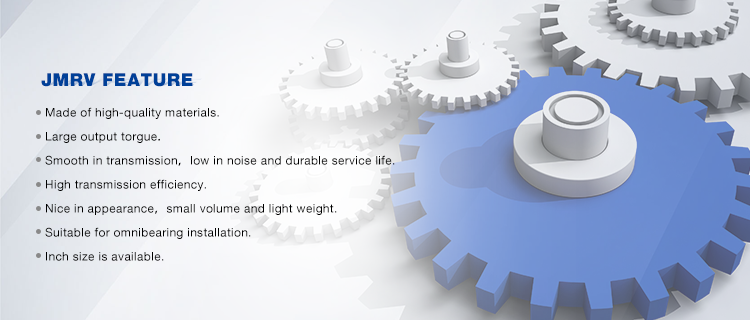

Personalized support .37 kw ac 220 tiny dc electric worm equipment reduction geared motor with gearbox




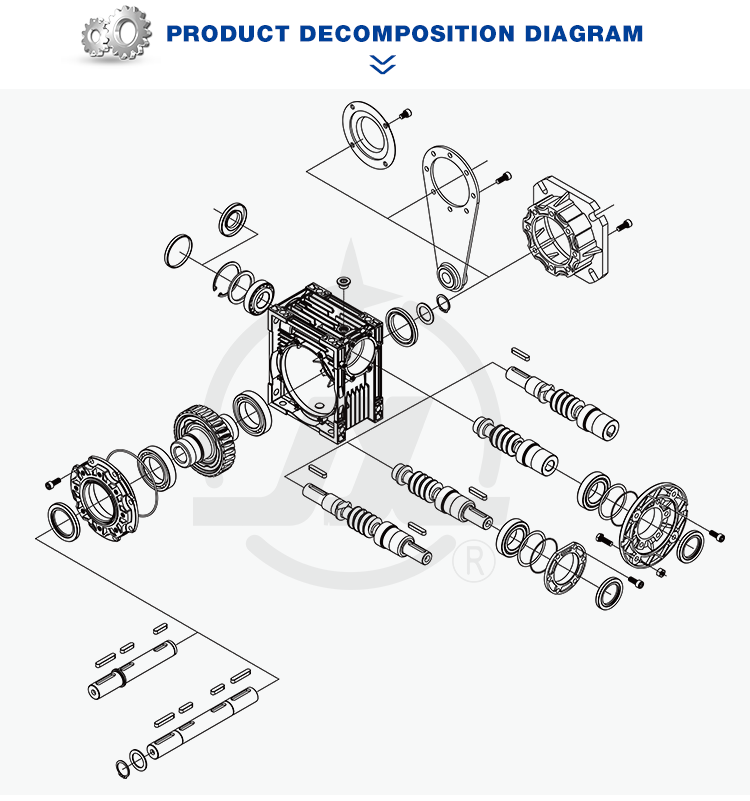

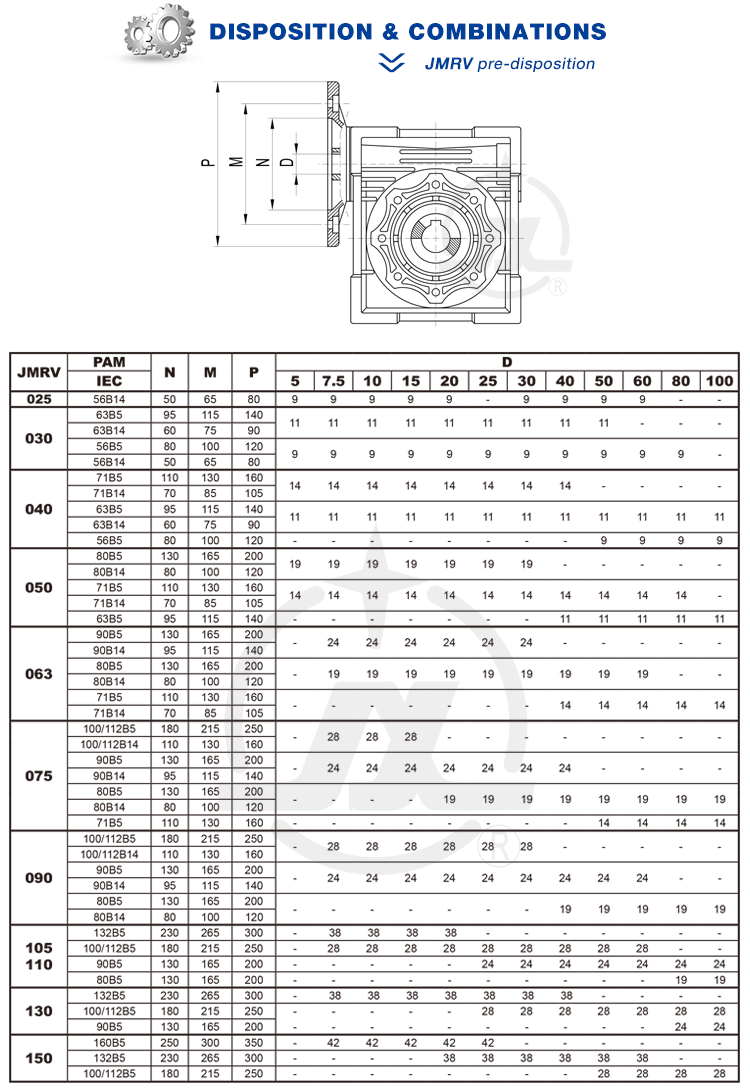

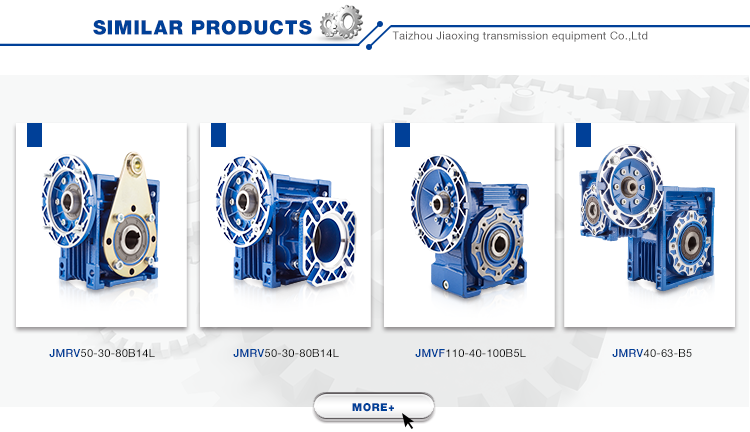

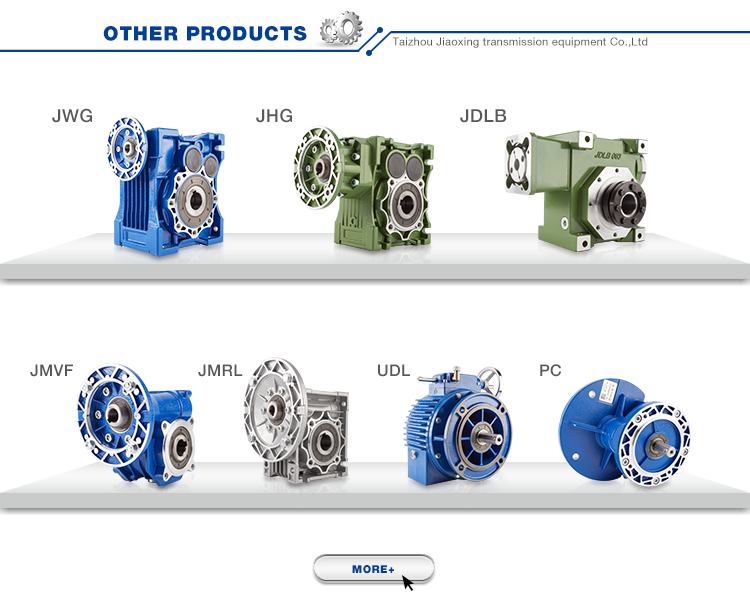

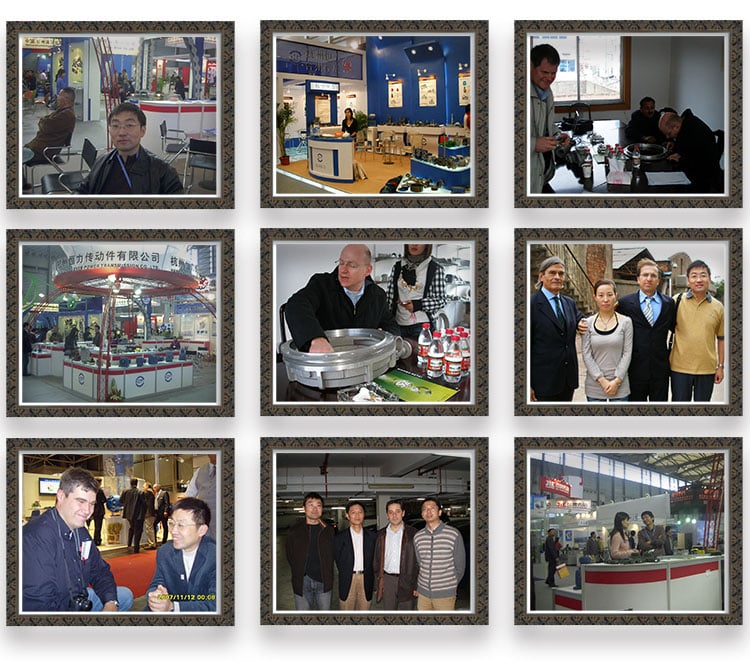



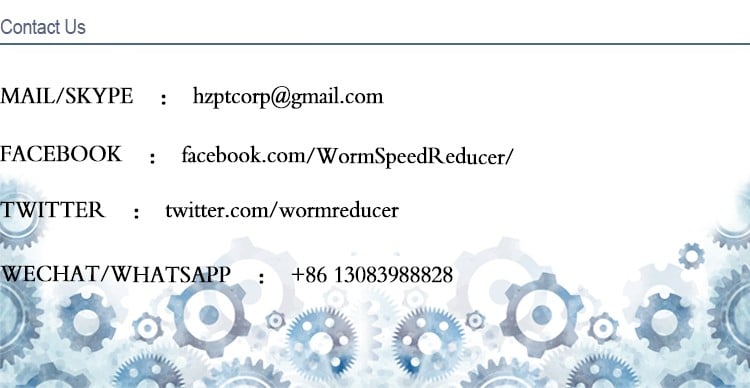

Q1.How to choose a geared motor which satisfies our need?
A1: You can refer to our catalogue to pick the gearbox or we can help to choose when you offer
the technical data of output torque, output speed and motor parameter and many others.
Q2.How is your price? Can you offer you any price cut?
A2: We will give the ideal price tag we can foundation on your demands and the portions.
Q3.Do you offer you any browsing?
A3: Indeed! We sincerely invite you to go to us! We can choose you from airport, railway station and so on.
Also, we can organize housing for you. You should allow us know in advanced.
This autumn.When is the best time to contact you?
A4: You can get in touch with us by email any time, we will reply you as shortly as feasible.
Q5.How extended will it consider for the direct time?
A5: For our common design, you should refer to the diverse solution paThe philosophy of our company is based mostly on 3 standard components: The customer: Our goal The top quality: Our cause of currently being Services: Our distinction These 3 pillars are the bases of our business since they are the masterful traces of our perform.ges to verify the direct time.
For the OEM/ODM merchandise, please get in touch with us for more information.








